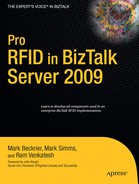In most industries, successful businesses are defined by the products, services, and solutions they create and deliver—in these times of economic uncertainty, a new paradigm of business is emerging. This new-generation business will be different and will be defined and measured by the effect it has and the value it adds to its shareholders and customers, and its customer’s markets—this forces a major rethink on strategies.
Real-time visibility into supply chains and operations is critical for the next-generation business. The promise of RFID is to improve supply chain business processes through global visibility of physical objects—products and other assets. Visibility not just within your own four walls, but also within your trading partners’ walls. Visibility is about getting access to new data and then transforming the data into real value.
Visibility enables traceability and authentication of products, enabling critical and life-saving processes such as effective recall, product authentication, brand protection, and chain of custody for pharmaceuticals.
The biggest challenge that companies face today is knowing where to start the journey, and how to get a firm grip on the potential areas of value creation and eventual return on investment. Project teams need to have a balanced focus across the following four pillars of value creation:
Increase revenue: Can this project help me increase company revenue?
Reduce costs: Where will the real cost savings come from?
Optimize assets: Can I find assets and redeploy them?
Reduce risk: Will visibility improve my recall processes, reducing our corporate risk?
The key to unlocking the ROI is a solid understanding of the underlying global supply chain standards such as the GS1 EPCglobal standards, and applying them pragmatically in applications and processes that can capture visibility data and rapidly transform the data into value that has a positive effect on a company’s bottom line. In simple terms, if you understand your supply chain processes, it becomes much easier for project teams to drill into the four pillars of value creation within these processes and expose areas of significant business value creation.
RFID has long been thought of as a critical component to such visibility solutions. Over the last decade, there have been major strides in the mainstreaming of RFID technologies for visibility applications in the hardware, software, interoperability, and acceptance dimensions. A lot of ground has been covered, but significant barriers still remain to the ubiquitous deployment of RFID solutions. The challenges now go beyond the physical or technical. As an industry, we need to have scalable ways to create expertise in the community, and transform the art of rolling out RFID solutions into a predictable, manageable process, if we try to make thousands of RFID deployments a reality. The good news is that hope is around the corner! Microsoft’s approach to RFID holds the promise to create a hardware/software platform that will be ready for mass deployment—a tall challenge, but one the industry is ready to embark on.
This book is an important step of that journey—it is structured, pragmatic, and fact-based, and has rich content from the learning of three talented authors who are experienced in deployments and in-depth dialog with customers and technology partners. It exposes another one of the key issues in the industry today: the lack of repeatable modular solutions that enhance interoperability vs. the creation of custom islands of functionality. The very different but complementary perspectives of the authors makes it an interesting journey of understanding: Ram Venkatesh was the architect of the Microsoft RFID vision, and he lays out the model behind the approach. Mark Simms and Mark Beckner talk to the technology from a very hands-on user perspective that comes from deep enterprise hardware and software deployments. The result is a cohesive dialog between the creators and the consumers of a platform, which should give you a unique insight into how to leverage the Microsoft platform in your deployment.
We are close to the tipping point with RFID. This book is a must-read for software developers, project teams, and industry consultants; it unlocks secrets to success and provides global thought leadership.
I am reminded of a famous comment by Dr. William Edwards Deming, the great quality guru who stated, “Survival is not compulsory.” In my opinion, only next-generation businesses will survive.
John Keogh
Senior Vice President, EPCglobal Canada and Traceability

